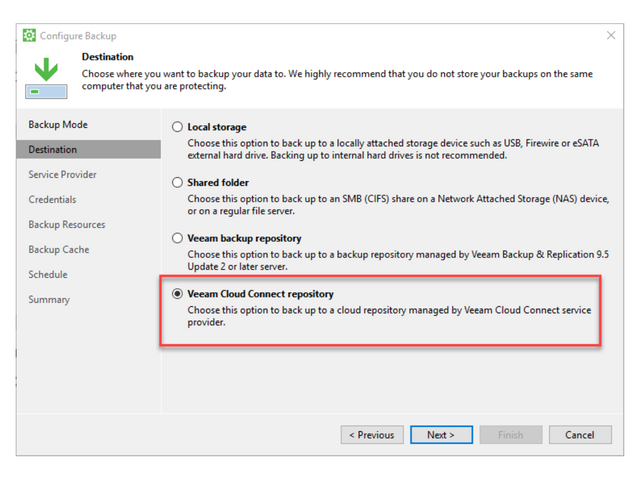New Features of Veeam Agent 2.0 for Microsoft Windows (Free & Paid Versions)
The product for backing up physical machines Veeam Agent for Microsoft Windows is quite popular both among IT administrators of companies and among users of home computers. In the second quarter of this year, version 2.0, already called Veeam Agent and with three different editions, including one free edition, was published. Today we will talk about several new features related to the work of this solution with storage, as well as support for Veeam Cloud Connect. We hope that one of these new products will be useful for you.

Encryption and Compression of Data
All editions support encryption of backup on the source side. In addition, you can adjust the Compression level and Storage optimization, as in Veeam Backup & Replication.
- All these options are available on the Storage tab of the Advanced Settings dialog – and it opens by clicking the Advanced button in the step of the job wizard, following the Destination.

With these settings, you can achieve the desired balance of performance and resource consumption.
Compression Level
- In a nutshell about how it works: Veeam reads blocks from the source and applies a compression algorithm to them according to the selected level. The size of the blocks is set by the Storage Optimization settings. Compressed blocks are already written to the repository.
Possible options:
- None (without compression) – can be used, for example, if you plan to save backups on storage with built-in compression and deduplication.
- Dedupe-friendly (optimized for deduplicating storage) – to reduce the load on the processor. Enables a simple RLE algorithm that does not require large processing power. It is optimal for working with storage with built-in deduplication as a repository.
- Optimal (recommended) is the default value. The LZ4 compression algorithm is applied. At the output, approximately half-compressed blocks are obtained, while the load on the processor rises very slightly. An optimal balance is ensured between the size of the backup file at the output and the time spent on processing during compression and decompression (data processing speed is from 150 Mb/sec for 1 core).
- High – add 10% to the compression ratio (compared to the Optimal level) at the cost of increasing processor load times. A zlib compression algorithm is used, “twisted”, taking into account the still not the maximum load on the processor. Data processing speed is up to 100 Mb/sec for 1 core.
- Extreme (extremely high) – the output is a backup of the minimum possible size (adds another 3-5% to the compression ratio), but the performance is reduced very significantly (the processing speed is about 50 Mb/sec for 1 core). A zlib algorithm is used, “twisted” taking into account the very high load on the processor. If you plan to use this option, it is highly recommended to have a powerful processor (cores of this sort 6). In general, extreme compression is rarely used, as a rule, if there is a channel with a very low bandwidth before the remote repository.
Optimizing the Size of Blocks with Storage System
Veeam Agent for Microsoft Windows allows you to configure the size of the data blocks to be processed, depending on the storage on which you are organizing the repository.
Here are some options:
- Local target (16 TB + backup files) – recommended for local storage and large backup files (from 16 TB). The block size is set to 4096 KB. The more blocks, the smaller their number and, correspondingly, the metadata table, which needs less storage space and a computational resource for processing. However, remember that this will increase the size of incremental backup files.
- Local target – recommended when backup on SAN, DAS or local storage. The block size is set to 1024 KB. Provides the best backup speed.
- LAN target – recommended when backup on NAS, as well as in a repository on the local site (onsite backup). The block size is set to 512 KB. Allows you to reduce the size of incremental backups.
- WAN target – recommended when using WAN for backups to a remote site. The block size is set to 256 KB. The traffic through the WAN is animated.
Note: Data compression settings can be edited at any time – they will be applied when the backup job is started up.
Backup to Repository on ReFS 3.1
ReFS is also implemented for Veeam Agent for Microsoft Windows 2.0, so now our agent can backup to the repository on a machine with Windows Server 2016 or Windows 10 Creators Update.
- For example, one of the innovations: when creating a synthetic backup our agent will use the technology of fast cloning – this significantly speeds up the process, without the need for additional disk space or computing resources.
So you can configure the regular creation of a synthetic full backup (in the Server or Workstation edition):

In the job history of the backup task, a line with the label [fast clone] appears in this case.

In addition, if you are configured to share Veeam Agent with Veeam Backup & Replication 9.5, then keep in mind that the new version of the agent supports a scalable repository, the ability to instantly restore to a virtual machine on a Microsoft Hyper-V platform, As well as the recovery in Microsoft Azure.
For users of the free Veeam Backup Free Edition, we inform you that if you decide to purchase a commercial version of Veeam Agent 2.0, after installing its license for a backup server, you can use the following features for physical backups:
- Working with repositories
- Configuring Backup Transfer Jobs Backup Copy Jobs
- Configuring file archiving tasks for tape files File to Tape Jobs
- All possible recovery of application objects (AD, Exchange, SharePoint, SQL, Oracle) – are supported by the agent in the server edition
Backup to the Veeam Cloud Connect Repository
Veeam Cloud Connect is the ability to create a repository for storing backups in the cloud on the side of the Veeam Cloud & Service Provider (VCSP). This repository helps to implement the rule “3-2-1” for backup, allowing you to store replicas and backups on the offsite site. You can manage the same repository as usual – via the Veeam Backup & Replication console. Initially, the Veeam Cloud Connect technology worked for virtual machines, and then it was implemented for the physical. So, starting with Veeam Agent for Microsoft Windows 2.0, we can back up to such a cloud repository and servers from a remote branch, and custom laptops.
Note: A backup to the cloud repository is available in the Workstation and Server editions.
- To do this, of course, you need to configure the Veeam Cloud Connect repository as the backup storage target in the backup task. Go to the Destination step of the task wizard and select the Veeam Cloud Connect repository.

- Next, you will go to the step of specifying the settings of the Service Provider. A detailed description of everything that needs to be done is read here.
- In short, you need to specify the name or address of the cloud gateway and the connection port received from the provider, and also verify the correctness of the TLS certificate and specify the account for accessing the cloud, and then select the required repository in the Backup Resources step.

Important! The Veeam Cloud Connect repository will not be able to make a full backup on demand (stand alone full backup). In addition, the backup of database transaction logs to such a repository is not supported – the corresponding option in the backup job settings for the database server will not be available.
Recover from the Veeam Cloud Connect repository
The Server and Workstation editions also support recovery from the cloud-based Veeam Cloud Connect repository:
- Recovery at the volume and file level directly from the repository, without having to copy the entire backup from the cloud to a local resource
- Restoring “bare metal” with the advanced media Veeam Recovery Media – this operation can also be performed directly by connecting to a cloud resource and selecting the desired recovery point from the repository.





